Wake Forest University
East Asian Languages and
Literatures, Chinese,
Patrick Edwin Moran
Zhu Zi Yu-lei, Juan 1, item 34
Traditional:
ÕöÉÕż¬Õ«Śńö©ÕģĄĶć│µźĄÕīŚĶÖĢ’╝īÕż£õ║”õĖŹµøŠÕż¬µÜŚ’╝īÕ░æķĀāÕŹ│Õż®µśÄ’╝īĶ¼éÕ£©
Õ£░Õ░¢ĶÖĢ’╝īÕÄ╗Õż®Õ£░õĖŖõĖŗõĖŹńøĖķüĀ’╝īµÄ®µŚźÕģēõĖŹńöÜÕŠŚŃĆéµÅÜŃĆé
Simplified:
ÕöÉÕż¬Õ«Śńö©ÕģĄĶć│µ×üÕīŚÕżä’╝īÕż£õ║”õĖŹµøŠÕż¬µÜŚ’╝īÕ░æķĪĘÕŹ│Õż®µśÄ’╝īĶ░ōÕ£©
Õ£░Õ░¢Õżä’╝īÕÄ╗Õż®Õ£░õĖŖõĖŗõĖŹńøĖĶ┐£’╝īµÄ®µŚźÕģēõĖŹńöÜÕŠŚŃĆéµē¼ŃĆé
Simplified
big5:
Łżė®vź╬¦L”▄Ęźź_│BĪA®]źńżŻ┤┐żėĘtĪAżų│╝¦Yżč®·ĪA┐ū”b
”a”y│BĪAźhżč”ażWżUżŻ¼█╗ĘĪA▒╗żķź·żŻ¼Ų▒oĪC┤ŁĪC
GB:
╠Ų╠½ū┌ė├▒°ų┴╝½▒▒┤”Ż¼ę╣ęÓ▓╗į°╠½░ĄŻ¼╔┘ŪĻ╝┤╠ņ├„Ż¼╬Įį┌
Ąž╝Ō┤”Ż¼╚ź╠ņĄž╔ŽŽ┬▓╗ŽÓįČŻ¼č┌╚š╣Ō▓╗╔§Ą├ĪŻč’ĪŻ
Translation:
The Tai-zong emperor of the Tang dynasty deployed troops to
the extreme north. Even at night it never got very dark and after
a short while it would be daylight again. The reason is that they
were at the sharp place of the earth where Heaven and Earth are
not very far apart and [Earth] was not greatly able to suppress
the light of the sun.
Yang
Commentary:
 According to the heliocentric explanation, which space travel and
other evidence has shown us to be reliable, the summer days are
very long in the earth because the north pole is pointed more toward
the sun in summer and more away from it in the winter. If, in fact,
you are right at the north pole, the sun will not set during part of the
summer.
According to the heliocentric explanation, which space travel and
other evidence has shown us to be reliable, the summer days are
very long in the earth because the north pole is pointed more toward
the sun in summer and more away from it in the winter. If, in fact,
you are right at the north pole, the sun will not set during part of the
summer.
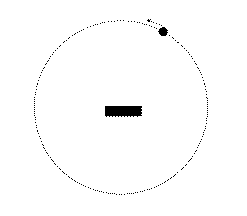 If you believe that the earth is a flat rectangular solid in the center of
a spherical Heaven, and that the sun rotates around the earth as diagrammed,
then there is no explanation for the greater length of the day during summer
at the north pole. Once the sun rises above the horizonal diameter line, all parts
of the earth will be equally well illuminated.
If you believe that the earth is a flat rectangular solid in the center of
a spherical Heaven, and that the sun rotates around the earth as diagrammed,
then there is no explanation for the greater length of the day during summer
at the north pole. Once the sun rises above the horizonal diameter line, all parts
of the earth will be equally well illuminated.
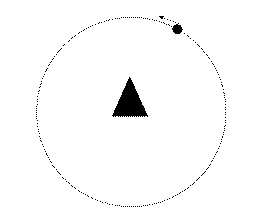 If it be assumed that the earth has a "point" like the peak of a great mountain,
then half of the earth would be illuminated during the first half of its cycle while the
sun is rising above the horizontal diameter line, and the other half of the earth
would be illuminated during the second half of its cycle while it is going down from
the zenith to the horizontal diameter line. If we believe that the sun has a constant
velocity across the sky, then this explanation does not fit reality at all well.
If it be assumed that the earth has a "point" like the peak of a great mountain,
then half of the earth would be illuminated during the first half of its cycle while the
sun is rising above the horizontal diameter line, and the other half of the earth
would be illuminated during the second half of its cycle while it is going down from
the zenith to the horizontal diameter line. If we believe that the sun has a constant
velocity across the sky, then this explanation does not fit reality at all well.
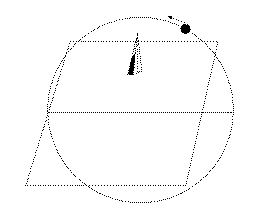 If we displace the peak to the north so that it is not on the plane defined by the orbit
of the sun, then the higher part of the peak would come into daylight earlier than the
lower part. But that peak could not serve as the pivot around which the sky rotates.
If we displace the peak to the north so that it is not on the plane defined by the orbit
of the sun, then the higher part of the peak would come into daylight earlier than the
lower part. But that peak could not serve as the pivot around which the sky rotates.
 If we look at the way the sun lights the real earth, we see that there is an area to the
right of the pole in the diagram that is still lighted when most of the world south of it
is enjoying night. But if we replace the spherical earth with a conical solid with its
point where the north pole would be, then it is easy to see that there is no lighted area
on the side away from the sun.
If we look at the way the sun lights the real earth, we see that there is an area to the
right of the pole in the diagram that is still lighted when most of the world south of it
is enjoying night. But if we replace the spherical earth with a conical solid with its
point where the north pole would be, then it is easy to see that there is no lighted area
on the side away from the sun.
 Zhu Xi claims that the earth's being "pointed" or "sharp" accounts for the short nights
experienced in the far north. We can rearrange our usual picture of the earth in
relation to the sun to depict the sun rotating around the earth. Actually, I've just
rotated the earlier picture 45 degrees in the clockwise direction to try to get an idea
of how Zhu Xi might have been picturing things to himself. It is clear that since
the north pole is not perpendicular to the direction of the sun's rays, there is an area
of the earth on the right side of the pole in the diagram where the sun's rays still
hit despite its being night. At the pole, since the earth is a very large sphere, the
land is almost entirely flat, and it is because of this fact that land to the
sun side of the pole and land to the other side of the pole is almost equally lighted for
dozens of miles. If the world were perfectly flat, it would always be daytime everywhere
the way I have set things up. But if there were a pointed earth, with the point where the
north pole is now, there would be equal periods of darkness during the night on any date.
And it is precisely because the peri-polar area does not approximate a plane.
Zhu Xi claims that the earth's being "pointed" or "sharp" accounts for the short nights
experienced in the far north. We can rearrange our usual picture of the earth in
relation to the sun to depict the sun rotating around the earth. Actually, I've just
rotated the earlier picture 45 degrees in the clockwise direction to try to get an idea
of how Zhu Xi might have been picturing things to himself. It is clear that since
the north pole is not perpendicular to the direction of the sun's rays, there is an area
of the earth on the right side of the pole in the diagram where the sun's rays still
hit despite its being night. At the pole, since the earth is a very large sphere, the
land is almost entirely flat, and it is because of this fact that land to the
sun side of the pole and land to the other side of the pole is almost equally lighted for
dozens of miles. If the world were perfectly flat, it would always be daytime everywhere
the way I have set things up. But if there were a pointed earth, with the point where the
north pole is now, there would be equal periods of darkness during the night on any date.
And it is precisely because the peri-polar area does not approximate a plane.
It is difficult to be sure of exactly how Zhu Xi explained the midnight sun to himself. Perhaps
the most that can be said is that he knew about the phenomenon and tried to explain it without
having the advantage of a heliocentric perspective.
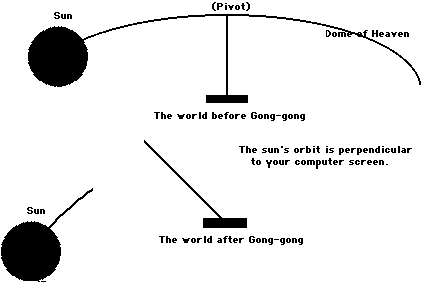 It is rather ironic that a phenomenon that argues against a flat-earth theory, because it is
hard to come with an explanation of the midnight sun on that assumption, is actually dependent
up the fact that the surface of a large sphere approximates a flat plane. In Zhu Xi's case, there
is a complication added by the theory that the pole star should center over China and act as the
pivot around which the hemisphere of heaven turns. Apparently nobody in Zhu Xi's circle thought
to experiment with a bowl and a square board. If they had, they would have realized that under
the supposedly normal conditions the sun could never have set, And only after Gong-gong had
knocked the pivot far to the north, and almost parallel to the surface of the land, would the sun
have given us some rest at night.
It is rather ironic that a phenomenon that argues against a flat-earth theory, because it is
hard to come with an explanation of the midnight sun on that assumption, is actually dependent
up the fact that the surface of a large sphere approximates a flat plane. In Zhu Xi's case, there
is a complication added by the theory that the pole star should center over China and act as the
pivot around which the hemisphere of heaven turns. Apparently nobody in Zhu Xi's circle thought
to experiment with a bowl and a square board. If they had, they would have realized that under
the supposedly normal conditions the sun could never have set, And only after Gong-gong had
knocked the pivot far to the north, and almost parallel to the surface of the land, would the sun
have given us some rest at night.
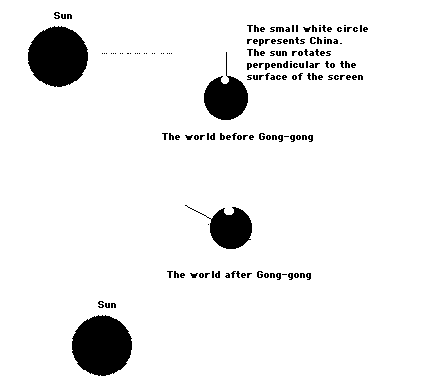 If you combine the idea of a round earth with the idea that the pivot was forcibly moved from its
proper center over China to somewhere far to the north, then you get a much more consistent picture,
and you can explain the midnight sun. But there is no sharp point to the earth beneath the north
star.
If you combine the idea of a round earth with the idea that the pivot was forcibly moved from its
proper center over China to somewhere far to the north, then you get a much more consistent picture,
and you can explain the midnight sun. But there is no sharp point to the earth beneath the north
star.
-- PEM
 According to the heliocentric explanation, which space travel and
other evidence has shown us to be reliable, the summer days are
very long in the earth because the north pole is pointed more toward
the sun in summer and more away from it in the winter. If, in fact,
you are right at the north pole, the sun will not set during part of the
summer.
According to the heliocentric explanation, which space travel and
other evidence has shown us to be reliable, the summer days are
very long in the earth because the north pole is pointed more toward
the sun in summer and more away from it in the winter. If, in fact,
you are right at the north pole, the sun will not set during part of the
summer.
 If you believe that the earth is a flat rectangular solid in the center of
a spherical Heaven, and that the sun rotates around the earth as diagrammed,
then there is no explanation for the greater length of the day during summer
at the north pole. Once the sun rises above the horizonal diameter line, all parts
of the earth will be equally well illuminated.
If you believe that the earth is a flat rectangular solid in the center of
a spherical Heaven, and that the sun rotates around the earth as diagrammed,
then there is no explanation for the greater length of the day during summer
at the north pole. Once the sun rises above the horizonal diameter line, all parts
of the earth will be equally well illuminated.
 If it be assumed that the earth has a "point" like the peak of a great mountain,
then half of the earth would be illuminated during the first half of its cycle while the
sun is rising above the horizontal diameter line, and the other half of the earth
would be illuminated during the second half of its cycle while it is going down from
the zenith to the horizontal diameter line. If we believe that the sun has a constant
velocity across the sky, then this explanation does not fit reality at all well.
If it be assumed that the earth has a "point" like the peak of a great mountain,
then half of the earth would be illuminated during the first half of its cycle while the
sun is rising above the horizontal diameter line, and the other half of the earth
would be illuminated during the second half of its cycle while it is going down from
the zenith to the horizontal diameter line. If we believe that the sun has a constant
velocity across the sky, then this explanation does not fit reality at all well.
 If we displace the peak to the north so that it is not on the plane defined by the orbit
of the sun, then the higher part of the peak would come into daylight earlier than the
lower part. But that peak could not serve as the pivot around which the sky rotates.
If we displace the peak to the north so that it is not on the plane defined by the orbit
of the sun, then the higher part of the peak would come into daylight earlier than the
lower part. But that peak could not serve as the pivot around which the sky rotates.
 If we look at the way the sun lights the real earth, we see that there is an area to the
right of the pole in the diagram that is still lighted when most of the world south of it
is enjoying night. But if we replace the spherical earth with a conical solid with its
point where the north pole would be, then it is easy to see that there is no lighted area
on the side away from the sun.
If we look at the way the sun lights the real earth, we see that there is an area to the
right of the pole in the diagram that is still lighted when most of the world south of it
is enjoying night. But if we replace the spherical earth with a conical solid with its
point where the north pole would be, then it is easy to see that there is no lighted area
on the side away from the sun.
 Zhu Xi claims that the earth's being "pointed" or "sharp" accounts for the short nights
experienced in the far north. We can rearrange our usual picture of the earth in
relation to the sun to depict the sun rotating around the earth. Actually, I've just
rotated the earlier picture 45 degrees in the clockwise direction to try to get an idea
of how Zhu Xi might have been picturing things to himself. It is clear that since
the north pole is not perpendicular to the direction of the sun's rays, there is an area
of the earth on the right side of the pole in the diagram where the sun's rays still
hit despite its being night. At the pole, since the earth is a very large sphere, the
land is almost entirely flat, and it is because of this fact that land to the
sun side of the pole and land to the other side of the pole is almost equally lighted for
dozens of miles. If the world were perfectly flat, it would always be daytime everywhere
the way I have set things up. But if there were a pointed earth, with the point where the
north pole is now, there would be equal periods of darkness during the night on any date.
And it is precisely because the peri-polar area does not approximate a plane.
Zhu Xi claims that the earth's being "pointed" or "sharp" accounts for the short nights
experienced in the far north. We can rearrange our usual picture of the earth in
relation to the sun to depict the sun rotating around the earth. Actually, I've just
rotated the earlier picture 45 degrees in the clockwise direction to try to get an idea
of how Zhu Xi might have been picturing things to himself. It is clear that since
the north pole is not perpendicular to the direction of the sun's rays, there is an area
of the earth on the right side of the pole in the diagram where the sun's rays still
hit despite its being night. At the pole, since the earth is a very large sphere, the
land is almost entirely flat, and it is because of this fact that land to the
sun side of the pole and land to the other side of the pole is almost equally lighted for
dozens of miles. If the world were perfectly flat, it would always be daytime everywhere
the way I have set things up. But if there were a pointed earth, with the point where the
north pole is now, there would be equal periods of darkness during the night on any date.
And it is precisely because the peri-polar area does not approximate a plane.
 It is rather ironic that a phenomenon that argues against a flat-earth theory, because it is
hard to come with an explanation of the midnight sun on that assumption, is actually dependent
up the fact that the surface of a large sphere approximates a flat plane. In Zhu Xi's case, there
is a complication added by the theory that the pole star should center over China and act as the
pivot around which the hemisphere of heaven turns. Apparently nobody in Zhu Xi's circle thought
to experiment with a bowl and a square board. If they had, they would have realized that under
the supposedly normal conditions the sun could never have set, And only after Gong-gong had
knocked the pivot far to the north, and almost parallel to the surface of the land, would the sun
have given us some rest at night.
It is rather ironic that a phenomenon that argues against a flat-earth theory, because it is
hard to come with an explanation of the midnight sun on that assumption, is actually dependent
up the fact that the surface of a large sphere approximates a flat plane. In Zhu Xi's case, there
is a complication added by the theory that the pole star should center over China and act as the
pivot around which the hemisphere of heaven turns. Apparently nobody in Zhu Xi's circle thought
to experiment with a bowl and a square board. If they had, they would have realized that under
the supposedly normal conditions the sun could never have set, And only after Gong-gong had
knocked the pivot far to the north, and almost parallel to the surface of the land, would the sun
have given us some rest at night.
 If you combine the idea of a round earth with the idea that the pivot was forcibly moved from its
proper center over China to somewhere far to the north, then you get a much more consistent picture,
and you can explain the midnight sun. But there is no sharp point to the earth beneath the north
star.
If you combine the idea of a round earth with the idea that the pivot was forcibly moved from its
proper center over China to somewhere far to the north, then you get a much more consistent picture,
and you can explain the midnight sun. But there is no sharp point to the earth beneath the north
star.